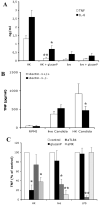Immune recognition of Candida albicans beta-glucan by dectin-1
- PMID: 18008237
- PMCID: PMC2655640
- DOI: 10.1086/523110
Immune recognition of Candida albicans beta-glucan by dectin-1
Abstract
Beta (1,3)-glucans represent 40% of the cell wall of the yeast Candida albicans. The dectin-1 lectin-like receptor has shown to recognize fungal beta (1,3)-glucans and induce innate immune responses. The importance of beta-glucan-dectin-1 pathways for the recognition of C. albicans by human primary blood cells has not been firmly established. In this study we demonstrate that cytokine production by both human peripheral blood mononuclear cells and murine macrophages is dependent on the recognition of beta-glucans by dectin-1. Heat killing of C. albicans resulted in exposure of beta-glucans on the surface of the cell wall and subsequent recognition by dectin-1, whereas live yeasts stimulated monocytes mainly via recognition of cell-surface mannans. Dectin-1 induced cytokine production through the following 2 pathways: Syk-dependent production of the T-helper (Th) 2-type anti-inflammatory cytokine interleukin-10 and Toll-like receptor-Myd88-dependent stimulation of monocyte-derived proinflammatory cytokines, such as tumor necrosis factor-alpha . In contrast, stimulation of Th1-type cytokines, such as interferon-gamma , by C. albicans was independent of the recognition of beta-glucans by dectin-1. In conclusion, C. albicans induces production of monocyte-derived and T cell-derived cytokines through distinct pathways dependent on or independent of dectin-1.
Figures



Similar articles
-
An anti-inflammatory property of Candida albicans β-glucan: Induction of high levels of interleukin-1 receptor antagonist via a Dectin-1/CR3 independent mechanism.Cytokine. 2015 Feb;71(2):215-22. doi: 10.1016/j.cyto.2014.10.013. Epub 2014 Nov 20. Cytokine. 2015. PMID: 25461401 Free PMC article.
-
Candida albicans beta-glucan exposure is controlled by the fungal CEK1-mediated mitogen-activated protein kinase pathway that modulates immune responses triggered through dectin-1.Infect Immun. 2010 Apr;78(4):1426-36. doi: 10.1128/IAI.00989-09. Epub 2010 Jan 25. Infect Immun. 2010. PMID: 20100861 Free PMC article.
-
Dectin-1 Stimulation of Hematopoietic Stem and Progenitor Cells Occurs In Vivo and Promotes Differentiation Toward Trained Macrophages via an Indirect Cell-Autonomous Mechanism.mBio. 2020 Jun 23;11(3):e00781-20. doi: 10.1128/mBio.00781-20. mBio. 2020. PMID: 32576672 Free PMC article.
-
Dectin-1 escape by fungal dimorphism.Trends Immunol. 2005 Jul;26(7):352-4. doi: 10.1016/j.it.2005.05.005. Trends Immunol. 2005. PMID: 15922664 Review.
-
CARD9 Syk-dependent and Raf-1 Syk-independent signaling pathways in target recognition of Candida albicans by Dectin-1.Eur J Clin Microbiol Infect Dis. 2011 Mar;30(3):303-5. doi: 10.1007/s10096-010-1103-z. Epub 2010 Nov 25. Eur J Clin Microbiol Infect Dis. 2011. PMID: 21108038 Review.
Cited by
-
Cell surface changes in the Candida albicans mitochondrial mutant goa1Δ are associated with reduced recognition by innate immune cells.Cell Microbiol. 2013 Sep;15(9):1572-84. doi: 10.1111/cmi.12135. Epub 2013 Mar 28. Cell Microbiol. 2013. PMID: 23490206 Free PMC article.
-
Anti-Aspergillus human host defence relies on type 1 T helper (Th1), rather than type 17 T helper (Th17), cellular immunity.Immunology. 2010 May;130(1):46-54. doi: 10.1111/j.1365-2567.2009.03211.x. Epub 2009 Dec 2. Immunology. 2010. PMID: 20002791 Free PMC article.
-
A multifunctional mannosyltransferase family in Candida albicans determines cell wall mannan structure and host-fungus interactions.J Biol Chem. 2010 Apr 16;285(16):12087-95. doi: 10.1074/jbc.M109.081513. Epub 2010 Feb 17. J Biol Chem. 2010. PMID: 20164191 Free PMC article.
-
Differential Transcriptional Responses of Human Granulocytes to Fungal Infection with Candida albicans and Aspergillus fumigatus.J Fungi (Basel). 2023 Oct 14;9(10):1014. doi: 10.3390/jof9101014. J Fungi (Basel). 2023. PMID: 37888270 Free PMC article.
-
Analysis of PRA1 and its relationship to Candida albicans- macrophage interactions.Infect Immun. 2008 Sep;76(9):4345-58. doi: 10.1128/IAI.00588-07. Epub 2008 Jul 14. Infect Immun. 2008. PMID: 18625733 Free PMC article.
References
-
- Gudlaugsson O, Gillespie S, Lee K, et al. Attributable mortality of nosocomial candidemia, revisited. Clin Infect Dis. 2003;37:1172–7. - PubMed
-
- Wisplinghoff H, Bischoff T, Tallent SM, Seifert H, Wenzel RP, Edmond MB. Nosocomial bloodstream infections in US hospitals: analysis of 24,179 cases from a prospective nationwide surveillance study. Clin Infect Dis. 2004;39:309–17. - PubMed
-
- van ’t Wout JW, Linde I, Leijh PCJ, van Furth R. Contribution of granulocytes and monocytes to resistance against experimental disseminated Candida albicans infections. Eur J Clin Microbiol Infect Dis. 1988;7:736–41. - PubMed
-
- Marodi L, Korchak HM, Johnston RB., Jr. Mechanisms of host defense against Candida species. 1. Phagocytosis by monocytes and monocyte-derived macrophages. J Immunol. 1991;146:2783–9. - PubMed
Publication types
MeSH terms
Substances
Grants and funding
LinkOut - more resources
Full Text Sources
Miscellaneous

